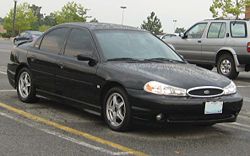- Ford SVT Contour
-
Ford SVT Contour 
Manufacturer Ford Motor Company Production 1998–2000 Class Sports sedan Body style 4-door sedan The SVT Contour was a modified version of the Ford Contour sedan from Ford's in-house Special Vehicle Team.[1] The SVT Contour was produced from 1998MY through 2000MY, with a mid-year revision for 1998.5. All Ford Contours were produced at the Ford Kansas City Assembly Plant (KCAP) in Claycomo, Missouri, just outside of Kansas City, Missouri.[1]
Contents
Year Engine Power Torque Production 1998 2.5 L Duratec 25 SVT V6 195 hp (145 kW) 165 ft·lbf (224 N·m) 4,485 1998.5 2,050 1999 200 hp (149 kW) 169 ft·lbf (229 N·m) 2,760 2000 2,150 Total 11,445 Year Exterior Color Blue Interior Tan Interior Total First Saleable Job 1 Job Last 1998 Red 1,238 N/A 1,238 8/29/96 3/24/97 1/27/98 Silver 1,631 N/A 1,631 Black 1,616 N/A 1,616 TOTAL 4,485 N/A 4,485 1998.5 Red 415 N/A 415 12/5/97 2/13/98 6/27/98 Silver 856 N/A 856 Black 779 N/A 779 TOTAL 2,050 N/A 2,050 1999 Red N/A 494 494 6/17/98 9/1/98 8/18/99 Silver 861 N/A 861 Black 379 532 902 Green N/A 503 503 TOTAL 1,231 1,529 2,760 2000 Red N/A 386 386 8/4/99 9/14/99 2/4/00 Silver 725 N/A 725 Black 307 525 832 Green N/A 207 207 TOTAL 1,032 1,118 2,150 GRAND TOTAL 8,798 2,647 11,445 Body and Interior
There were many SVT-specific parts that separated it from the normal Ford Contour models.
- SVT-specific front bumper (for enhanced cooling), rocker sill extensions, rear bumper
- SVT mesh front and lower grills
- SVT emblem on rear left trunk
- SVT-marked floor mats
- Leather shift and emergency brake boot
- White face gauge cluster
- Leather sport seats front and back (Midnight Blue or Tan)
Drivetrain Differences
The SVT Contour has many high-performance improvements to produce more power and withstand harder driving than the normal Contour models.
These changes include:
- Changes to the camshaft include a longer duration and a complete change in valve timing points.
- Higher compression: 10:1 (SVT) vs 9.7:1 (normal)
- Powertrain Control Module (PCM) was more aggressively tuned and required premium fuel.
- Larger throttle body (60 mm vs 54 mm). Lifted from the 3.0L Duratec.
- 19 lbs fuel injectors.
- Upper intake manifold was extrude-honed, increasing cfm flow (from 165 stock to 185 cfms)
- Lower intake manifold was enlarged (from 32/33mm to 33/34mm for the SVT model)
- SVT-specific clutch.
- A water-to-oil, oil cooler to keep control of oil temperatures during performance driving.
- A radiator with a thicker core for better cooling (lifted from Saudi models).
- Different air filter and intake (cone style using same air filter as V6 Mustang).
- A lighter flywheel (from 21 to 19 pounds or 9.5 to 8.6 kilograms)
- A larger-diameter, quasi-dual exhaust.
These changes allowed the SVT Duratec to make 200 hp at 6600 rpm and 169 lb-ft at 5500 rpm. The rev-limiter was also raised to 6750 rpm from 6500 rpm.
Suspension and Brakes
Cars built on or before January 27, 1998 had the first 5-spoke wheel style with Goodyear GSC tires. Beginning on February 14, Ford switched to the Cobra style 16-inch (41 cm) wheel and Eagle F1 tires. Beginning with 1999MY, September 1, 1998, Ford then kept the same Cobra-style wheel and switched to the BF Goodrich KDW tires. The SVT Contour had four-wheel disc brakes, instead of the standard mixed disc/drum configuration. The independent rear disc-brake suspension is also used in the 1999-2002 Mercury Cougar.
- Front rotors were enlarged to 278 vs 260 millimetres (stock) or 10.9 vs 10 in.
- Stiffer shock tuning.
- Smaller front swaybar (down to 19mm).
- 16-inch (41 cm) five-spoke wheels (1998MY)
- 16-inch (41 cm) SVT Cobra-style wheels (1998.5 to 2000MY)
- Goodyear Eagle GS-C tires, size 205/55ZR16 (1998MY)
- Goodyear Eagle F1-GS tires, size 205/55ZR16 (1998.5MY)
- BFGoodrich g-Force KDW tires, size 215/50ZR16 (1999 to 2000MY).
- Lighter SVT Edition Wheels
See also
References
External links
- "Official site". Ford SVT. http://www.svt.ford.com/. Retrieved march 8, 2006.
- Contour.org
- FordContour.org
Pictures
Categories:- Ford SVT vehicles
Wikimedia Foundation. 2010.
